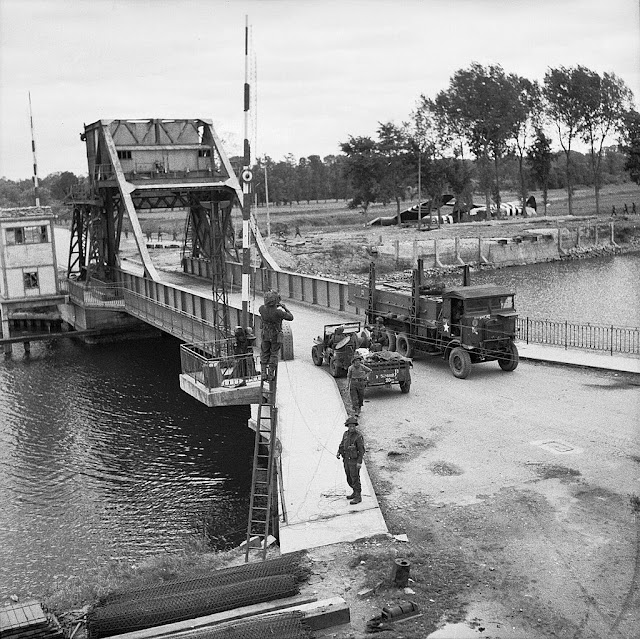1/144 Pegasus Bridge (1944) - CGD
In commemoration of the 75th Anniversary of D-Day, CGD present you with an 1/144 scale working bascule bridge model based on the ORIGINAL 1944 Bénouville Bridge , or more famously known as Pegasus Bridge, as exhibited in Mémorial Pégasus.
Order directly on Shapeways:
https://www.shapeways.com/product/Y9PQYVLBV/1-144-pegasus-bridge-d-day-75th-anniversary?optionId=105743006&fbclid=IwAR0EF0WlsgScssJ_AAm6F1lKpWC0JcWHsMDqWc1V3lbCqD01cIvsGN-qJWw
Pegasus Bridge is a sub type of bascule bridge, the "Scherzer rolling lift bascule bridge" or "rolling bridge". Bridges of this type do not pivot about a hinge point, but roll back on curved tread plates attached to the girders of the main span. This design allows a greater clearance of the waterway for a given opening angle.
Move the engine room of this model backwards will roll back and raise the bridge.
Assembly instructions in PDF format can be downloaded here. https://www.combatgroupdynamix.com/New2019/Accessories/Bridges/PegasusBridgeShapeways/CGD_PegasusBridge_AssemblyInstruction_V1.pdf
Model measures 9.5 cm X 32 cm X 8 cm ( 3.75" X 12.7" X 3.2") when assembled. Bridge section can be raised by moving the engine room backwards.
More information and assembly instructions here:
https://www.combatgroupdynamix.com/Opening2019/PegasusBridgeIndex.html
With this 1:144 Pegasus Bridge, highly detailed and realistic, is specially designed for creating dioramas or wargame battlefields. Compatible with our 1:144 armour, especially the CGD Horsa glider, and other WTM and Cando products.
http://www.facebook.com/pages/CombatGroupDynamix/145539380721
https://www.shapeways.com/shops/combatgroupdynamix
http://www.combatgroupdynamix.com/Diorama/WargameSeries/144Armour.html
Operation Deadstick
22:30 5th June, Operation Deadstick set off "The Longest Day".
The objective was to capture intact two road bridges in Normandy across the River Orne and the Caen Canal.
Responsibility for the operation fell to the members of 'D' Company, 2nd (Airborne) Battalion, Oxfordshire and Buckinghamshire Light Infantry, part of the 6th Airlanding Brigade of the 6th Airborne Division. The assault group comprised a reinforced company of six infantry platoons and an attached platoon of Royal Engineers. They flew from the south of England to Normandy in six Airspeed Horsa gliders.
At 22:30 on the 5th June, the first of six Halifax aircraft from 298 and 644 Squadrons, each towing a Horsa glider containing men of Major Howard's coup de main force, began to take-off from Tarrant Rushton.
At 00:16 on the 6th June 1944, Glider No.92, containing Major Howard and No.1 Platoon of the coup de main force, approached their objective, Bénouville bridge. Once landed, they proceeded to attack and take over the bridge.
Lieutenant Den Brotheridge and Lance corporal Fred Greenhalgh became the first British soldier casualties on D-Day.
Another three gliders landing near the River Orne to attack and take over Ranville bridge.
After a brief exchange of fire, both bridges were captured had been taken in just ten minutes.
The operation was later hailed by Air Vice-Marshal Leigh-Mallory, the commander of Allied air forces during the invasion, as "one of the most outstanding flying achievements of the war."
In 1944 Bénouville bridge was renamed Pegasus Bridge in honour of the operation. The name is derived from the shoulder emblem worn by the British airborne forces, which is the flying horse Pegasus.
https://en.wikipedia.org/wiki/Operation_Deadstick
By Christie (Sgt), No 5 Army Film & Photographic Unit - http://media.iwm.org.uk/iwm/mediaLib//36/media-36070/large.jpgThis is photograph B 5288 from the collections of the Imperial War Museums., Public Domain, https://commons.wikimedia.org/w/index.php?curid=24488751








No comments:
Post a Comment